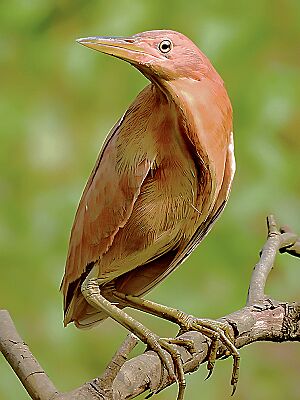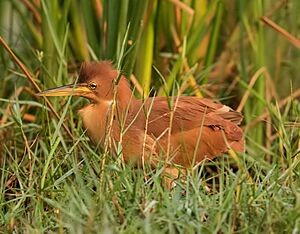Cinnamon bittern facts for kids
Quick facts for kids Cinnamon bittern |
|
|---|---|
 |
|
| Ixobrychus cinnamomeus
from Mangaon, Maharashtra, India |
|
| Conservation status | |
| Scientific classification | |
| Genus: |
Ixobrychus
|
| Species: |
cinnamomeus
|
 |
|
| Breeding Year-round Nonbreeding | |
The cinnamon bittern (Ixobrychus cinnamomeus) is a small bird found in Asia. It's also known as the chestnut bittern. These birds live in warm, wet places across tropical and subtropical Asia. You can find them from India all the way to China and Indonesia. Most cinnamon bitterns stay in one area all year. However, some birds from cooler northern regions might fly short distances to warmer spots for winter.
Contents
About the Cinnamon Bittern
The cinnamon bittern is a type of bittern. Bitterns are wading birds, similar to herons. They are known for living in thick reeds and being quite shy.
What's in a Name?
The cinnamon bittern got its official name in 1789. A German scientist named Johann Friedrich Gmelin described it. He named it Ardea cinnamomea. The word cinnamomeus is Latin and means "cinnamon coloured." This describes the bird's reddish-brown feathers.
Today, the cinnamon bittern is part of a group of birds called Ixobrychus. This name comes from ancient Greek words. Ixias means a reed-like plant, and brukhomai means to bellow. This fits the bird's home in the reeds and its calls.
What Does It Look Like?

The cinnamon bittern is a small bird. It is about 38 centimeters (15 inches) long. It has a short neck and a fairly long beak.
- Males: Male cinnamon bitterns are a uniform cinnamon color on their backs. Their undersides are a buff (light yellowish-brown) color.
- Females: Females look similar to males. But their backs and the tops of their heads are more brown.
- Young Birds: Young bitterns look like females. However, they have more brown streaks on their undersides.
When a cinnamon bittern feels threatened, especially near its nest, it does something special. It stretches its neck straight up. Its beak points towards the sky. The bird then freezes. This pose is called the on-guard position. It helps the bird blend in perfectly with the tall reeds around it, making it very hard to spot!
Where Do They Live?

Cinnamon bitterns live across a very large area in Asia. They breed in many countries, from India to Indonesia. Sometimes, these birds fly to new places. They have been seen in places like Micronesia and the Seychelles.
Scientists believe there are many cinnamon bitterns in the world. Estimates suggest there could be anywhere from 130,000 to 2,000,000 of these birds.
Their Home Environment
Cinnamon bitterns love to live in reed beds. These are areas filled with tall, thick reeds. They also like other wet places like marshes and swamps. These habitats provide good cover and plenty of food.
How Do They Live?
Cinnamon bitterns are often hard to see. This is because they are shy and like to hide in the reeds. They usually come out more around sunset. This is when they search for food. They move very quietly, almost like a cat.
Nesting and Babies
When it's time to have babies, cinnamon bitterns build their nests. They make platforms out of reeds. These nests are often hidden in shrubs within the reed beds. A female bittern usually lays four to six eggs.
What Do They Eat?
Cinnamon bitterns are good hunters. They eat a variety of small creatures found in their wet homes. Their diet includes:
- Insects
- Small fish
- Amphibians, like frogs


